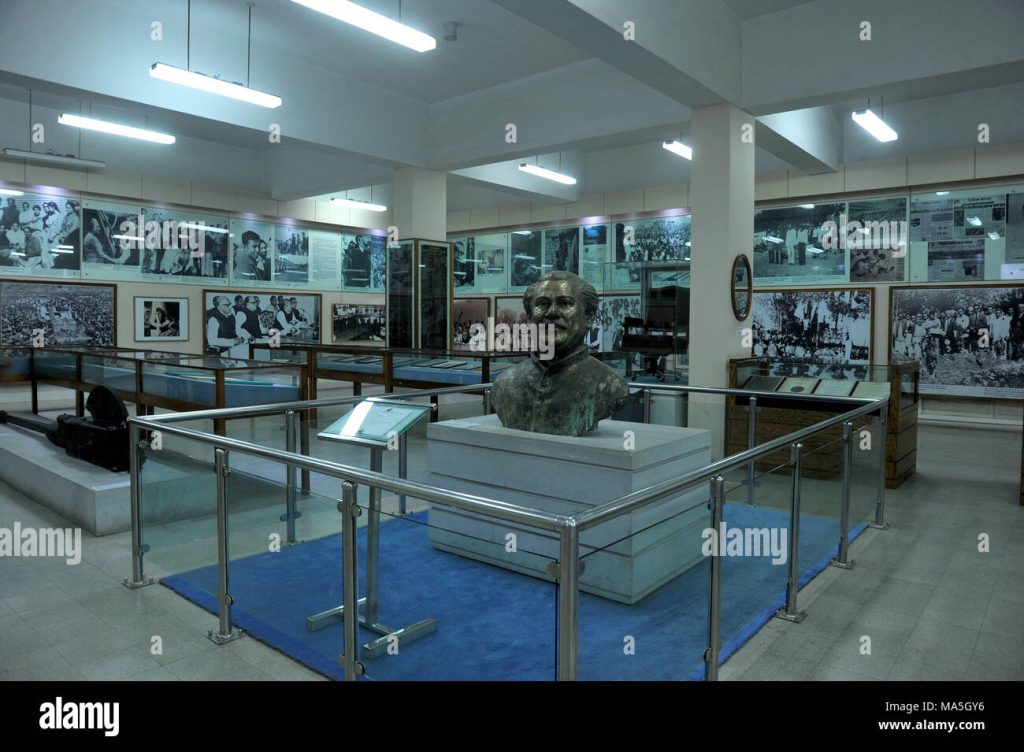The National Museum of Science and Technology
The National Museum of Science and Technology (NMST) is the country’s top organization,
And working to raise scientific awareness, technology training, and innovation.
Since it was created to inspire and people towards science.
NMST is an organization where students, scientists, and supporters of technology can acquire knowledge on various branches of science.
With interactive exhibits, hands-on experiments, and research-based initiatives, the museum provides a platform to witness the latest science, engineering, and technology advancements.
Science museums like NMST are the cornerstone of education and technological progress.
Because are they complement STEM (Science, Technology, Engineering ).
They are the chasm between theory and practice, with interactive exhibits that make abstract scientific concepts more straightforward.
Museums inspire young minds towards science and innovation professions, inculcating a culture of creativity and critical thinking.
They also draw attention to worldwide matters such as climate change, space expeditions, and sustainability.
NMST promotes science awareness and innovation through exhibitions, science fairs, workshops, and collaborative research.
NMST, in collaboration with academic institutions and industries, drives technological development and innovation.
In the process, NMST continues to inspire generations of scientists, engineers, and innovators and facilitate Bangladesh’s advancement in science and technology.
History and Formation:
The National Museum of Science and Technology (NMST) was established in 1966 in Dhaka, Bangladesh, to promote mass scientific consciousness and education.
The museum was established to inspire curiosity, imagination, and innovation by providing an interactive atmosphere to learn various sciences.
Through the years, NMST has been instrumental in promoting a culture of scientific learning and bridging the gap between theoretical know-how and practical application.
NMST desires to establish a science-aware society founded on technology progression, research, and innovation.
To provide an educational and interactive learning atmosphere for researchers, students, and guests to engage in the wonders of science, engineering, and technology.
Through exhibitions, workshops, and outreach programs, the museum aims to enhance STEM Science, Technology, Engineering, and Mathematics education and develop future scientists and innovators.
NMST has made significant progress year by year, with more exhibition halls, research centers, and educational courses.
It has launched interactive galleries on space, robotics, alternate energy, and environmental science.
Continuous updates and interactions with centers of education and industry helped to increase the contribution of NMST to developing science in Bangladesh and a prestigious center of science education and innovation.
Infrastructure and Location:
The National Museum of Science and Technology (NMST) is located at Agargaon, Dhaka, Bangladesh, in the central and east-accessible part of the capital city.
Its proximity to government offices, schools, and major highways makes it accessible for students, researchers, and the general public.
Public transport, including buses and ride-hailing service providers, has easy access to the museum, embracing thousands of visitors every year.
The infrastructure and the design of NMST are intended to give an educational and interactive experience.
The museum possesses various exhibition halls, a 3D theater, an open science park, and science and technology-specific galleries on multiple topics.
The exhibitions are organized hierarchically so visitors can learn about physics, biology, space science, robotics, artificial intelligence, and renewable energy.
The open science park has outdoor displays of engineering models, solar power projects, and scientific interactive installations.
Visitors to NMST can use world-class facilities . Such as guided tours, a digital library, experimental hands-on spaces. And a separate children’s science area.
The museum also conducts science fairs, workshops, and astronomy viewing sessions.
Focusing on hands-on experience and involvement, NMST provides an interactive and engaging environment for discovering science and technology.
The National Museum of Science and Technology (NMST) features a wide range of permanent and temporary science exhibitions that showcase innovation in various fields of science.
The permanent exhibitions cover topics such as physics, chemistry, biology, space science, and engineering.
providing a sound foundation for understanding fundamental scientific principles.
Meanwhile, the temporary exhibitions tackle new technologies and scientific breakthroughs.
Including artificial intelligence, robotics, alternative energy, and medical technology.
The temporary exhibitions allow individuals to keep abreast of the latest developments in science and technology.
Display of Technological Innovations and Developments:
NMST aims to showcase technological developments in its exhibits, and guests can explore. The museum’s offerings over time, including past and current inventions.
Displays have advancements in scientific communication, transportation, medicine, and space research.
Interactive electronic display screens display elaborate descriptions, videos, and animations of technological innovations and how they affect society.
Hands-on Interactive Displays and Experiential Learning Opportunities:
One of NMST’s strongest draws is its hands-on learning activities and interactive exhibits, which seek to make science learning fun and engaging.
Visitors can perform experiments, interact with physics and chemistry models, and experience prototyping engineering.
Special sections allow the students to build simple circuits, experiment with robots, and view augmented and virtual reality demonstrations.
The interactive activities heighten the efficacy of learning the subject matter and nurture curiosity and creativity in young minds.
Space and Astronomy Section:
The Space and Astronomy Section is among the significant draws of NMST, with model planets, dummy satellites, and displays of deep space exploration.
The museum offers hands-on star-gazing demonstrations, telescopic perceptions, and 3D depictions of space exploration.
Special exhibits offer details on the solar system, black holes, and the history of space exploration so one can catch a glimpse of the universe’s secrets.
Robotics, AI, and Engineering Exhibits:
NMST has sections for robotics, artificial intelligence, and engineering, where one can discover programmable robots, AI-based systems, and engineering marvels.
Experiments with mockups of self-driving cars, humanoid robots, and industrial automation provide a preview of the future.
Engineering exhibits contain structural models, mechanical innovations, and computing technologies demonstrating engineering’s contribution to modern development.
Exhibits on Environment and Renewable Energy:
To promote environmental awareness and sustainability, NMST features exhibits on climate change, alternative green energy sources, and environmental conservation.
Public members can see solar panels, windmills, and hydroelectric power models and learn about alternative clean energy.
Simulation demonstrates how global warming affects ecosystems and how technology can be applied to combat environmental challenges.
With these wide-ranging illustrations, NMST is today a hub of scientific learning and innovation that inspires the younger generation to explore, learn, and contribute to technological advancements.
Educational Programs and Activities:
National Museum Hallroom

The National Museum of Science and Technology occasionally organizes science workshops and training programs to engage students, teachers, and professionals in hands-on scientific learning.
These workshops cover various subjects, such as robotics, artificial intelligence, space science, environmental technology, and renewable energy.
These workshops are conducted by experts and researchers, during which participants can implement practical know-how of the STEM fields.
Using practical demonstrations, coding exercises, and science experiments, the volunteers develop an understanding of how technological innovation today happens.
School and University Student Engagement Programs:
NMST actively collaborates with schools, colleges, and universities for science education.
Occasionally, students from schools are escorted on visits to the museum displays, interactive zones, and science demonstrations.
The museum also conducts science contests, innovation challenges, and research initiatives to test the students’ creative thinking.
Science Olympiads, robot challenges, and engineering hackathons are special programs that allow students to showcase their talent and problem-solving skills.
STEM (Science, Technology, Engineering, and Mathematics) Promotion
To propagate a good STEM culture, NMST designates programs highlighting the role of science, technology, engineering, and mathematics in everyday life.
The museum’s educational exhibits and experiential experiences facilitate students’ improvement in critical, analytical, and problem-solving thinking.
Through mentorship courses and career advice workshops, NMST encourages young students to pursue higher studies and professional development in STEM.
Public awareness campaigns and events:
Besides educational interest, NMST is busy generating public consciousness of scientific and technological problems.
The museum organizes special events, science fairs, astronomy nights, and sustainability campaigns to raise public awareness.
Seminars, exhibitions, and discussions with expert panels will address subjects ranging from global warming to space travel, artificial intelligence, and green technology.
By involving the community in the events, NMST promotes questioning and invites society to embrace scientific innovation for a better future.
Through these diverse activities, NMST is an active hub for science learning, innovation, and public engagement, fostering a culture of scientific inquiry and technology development in Bangladesh.
Research and Innovation Initiatives:
The National Museum of Science and Technology (NMST)plays an integral role in research and experimentation by providing space for researchers, students, and innovators to test in different areas of science.
The museum provides hands-on experimentation, prototype creation, and scientific research on robotics, renewable energy, space science, and artificial intelligence.
NMST promotes research for curiosity, allowing individuals to try out hypotheses and use science to solve real-world problems.
Partnership with Academic Institutions and Industries:
Statues of Dinosaur National Museum of Science and Technology

NMST collaborates with colleges, research organizations, and industries to develop scientific education and technological innovation.
The museum collaborates closely with engineering and technology colleges to organize research projects, industrial training courses, and workshops.
Increased association with technological organizations and government agencies facilitates closing the gap between academic research and industrial innovation.
Such interactions expose students and specialists to novel technologies and emerging scientific trends.
Advances in Technological Innovation and Science Education:
As a hub for technological innovation and science education, NMST promotes STEM science, Technology, Engineering, and Mathematics.
It fosters a culture of innovation by conducting science fairs, hackathons, and technology expos, which produce future scientists and engineers.
By bridging the gap between theory and practice, NMST encourages the scientific literacy and technological progress of Bangladesh and the world.
Special Events and Festivals
The National Museum of Science and Technology (NMST) is an active scientific experimentation and research facility that promotes discovery and innovation.
The museum provides robust learning environments, research labs, and experimental spaces for students and researchers to explore different scientific fields, including robotics, space science, for renewable energy, and artificial intelligence.
By performing practical demonstrations, prototype development projects, and scientific inquiry, NMST bridges the gap between theoretical education and practical applications.
Collaboration with Academic Institutions and Industries:
NMST proactively collaborates with universities, research organizations, and industries to advance scientific research and technological innovations.
The museum works with engineering colleges, IT companies, and government ministries
to organize joint research projects, industrial training programs, and education workshops.
Such collaborations facilitate the integration of academic research and industrial applications,
allowing students and professionals to access new scientific developments and innovations.
Contributions to Science Education and Technological Innovation:
NMST is a pioneer institution for technological innovation and science education. It is a valuable institution that promotes STEM (Science, Technology, Engineering, and Mathematics) education.
Through science fairs, exhibitions, and innovation competitions, the museum encourages young minds to develop problem-solving skills, think innovatively, and pursue science and technology careers.
NMST significantly contributes to Bangladesh’s scientific and technological advancement by fostering innovation and inspiring future generations.
Visitor Experience and Tourism Impact:
The National Museum of Science and Technology (NMST) offers affordable ticket prices to draw people in for science learning.
The admission fees vary for students, regular visitors, and international visitors, with discounts offered to school groups and learning centers.
Tickets are purchased at the entrance or via the museum’s website.
Special passes are also provided for science fairs, workshops, and exhibitions.
The entry process is hassle-free, with unique information desks and visitor assistance services to guide visitors. Guided Tours and Visitor Facilities
NMST provides a guided tour by science teachers and professionals to enhance knowledge about exhibits among the visitors.
Guided tours include interactive sessions, live demonstrations, and experiments to provide an enjoyable and valuable museum experience.
The museum also offers a digital library, science park, food court, resting areas, and shopping arcade, which provide further variety and range of facilities.
Wheelchair ramps, parking, and children-friendly areas make visits accessible for everyone.
Facilitation of Science Tourism in Bangladesh:
Being a hub of excellence for science studies and innovation, NMST is a key source of science tourism in Bangladesh.
It attracts students, researchers, and science enthusiasts from all over the country and the globe.
With international exhibitions, space observation activities, and STEM competitions, NMST facilitates the creation of Bangladesh’s knowledge economy and scientific advancements, making it a prime destination for science exploration.
Challenges and Future Development:
Despite its contribution to promoting science education, the National Museum of Science and Technology (NMST) faces several challenges.
Insufficient funds and resources hinder the expansion of research facilities and the embracing of sophisticated technologies.
Modernization and technological updating are necessary for specific exhibits to enhance their appeal and relevance.
Space limitations are another limiting factor constraining the provision of interactive exhibits and sophisticated laboratories.
Digital accessibility, visitor engagement, and interactive learning experiences are some aspects that should be enhanced.
Expansion and Modernization Plans:
“Modernizing Systems to Align with Evolving Market Needs”
NMST has plans to expand and modernize aggressively its facilities.
Some developments in the pipeline are the addition of state-of-the-art robotics laboratories, AI-powered interactive exhibitions, a planetarium, and an enlarged science park.
The museum also considers introducing virtual and augmented reality experiences to make learning more experiential.
Expansion plans will be focused on increasing exhibit space, adding visitor amenities, and introducing digital platforms for virtual tours and online learning.
Future Growth Support from the Government and Private Sector:
The government of Bangladesh has pledged increased investment in the development of NMST, recognizing its role in STEM education and technological advancement.
Collaborations with private technology companies, universities, and global organizations are being explored to introduce sponsored exhibits, research grants, and industrial training programs.
Through continued investment and modernization, NMST will become a world-class institution for science education and innovation in Bangladesh.
Conclusion:
The National Museum of Science and Technology (NMST) can contribute to Bangladesh’s science education and public awareness.
Through interactive displays, hands-on workshops, and research experiences, the museum instills curiosity and fosters a culture of scientific learning.
NMST’s commitment to STEM education, technological innovation, and advancements makes it an essential institution for students, scientists, and science lovers.
The museum bridges theoretical knowledge and practical applications through collaborations with industries and academic institutions.
Encouraging Students and Science Enthusiasts to Visit
NMST provides a dynamic and interactive experience to individuals of all ages.
Through hands-on displays and guided tours, students can acquire knowledge of space science, robotics, artificial intelligence, and environmental technology.
Science enthusiasts and researchers can benefit from special exhibitions, competitions, and innovation challenges.
A visit to NMST broadens knowledge and encourages creativity, critical thinking, and a sense of discovery.
With expansion and modernization strategies, NMST will be a world-class facility for science education.
With continued government and private support, NMST will be at the forefront of shaping Bangladesh’s science, technology, and innovation destiny.



